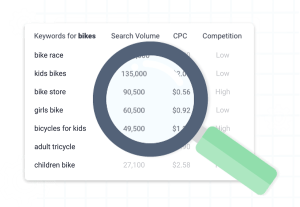Let’s dive into the intricacies of finding SEO keywords use in your social media.
This guide will explore the aspects of keyword research and SEO-optimized content that increases your social media searchability and presence.
1. Understand Your Audience:
Understanding your audience is fundamental to effective keyword research. Identify the demographics, preferences, and pain points of your target audience.
This helps you figure out what they search for and why. Knowing this helps you choose the right keywords that match what your audience is looking for.
2. Keyword Research:
Use tools like Ahrefs’ Keyword Generator, SEMrush, WordStream or other reputable SEO keyword research tools.

Look for keywords with high organic traffic potential and low Keyword Difficulty scores. That means keywords that many people search for and aren’t too difficult to rank for.
Keyword Difficulty scores indicate how hard it is to rank for a particular keyword. By focusing on keywords with high traffic potential and low competition, you increase your chances of ranking higher in search results.
3. Identify Long-tail Keywords:
Long-tail keywords are specific, detailed search queries that often have a lower search volume compared to general keywords. These keywords may not have a lot of searches, together they can bring a lot of targeted visitors to your site.
Detailed phrases show exactly what the person is looking for so that can lead to more sales or interactions.
4. Analyze the Competition:
See what others who use the same keywords are doing. Look at things like their website’s strength, backlinks, and the quality of their content. Understanding your competition helps you assess the level of effort required to outrank them. It also provides insights into the type of content your audience likes. and the strategies that are effective in your niche.
5. Create Content Infused with Best SEO Practices:
Develop a comprehensive content strategy based on the keywords you’ve identified. This strategy should encompass various types of SEO content, including blogs/articles, case studies, infographics, and videos. Diversifying your content types caters to different audience preferences and enhances user engagement.
Make sure your content is valuable and interesting to your visitors. High-quality content not only ranks better on search engines but also keeps your visitors engaged.
6. Optimize Your Website:
Make sure your website is easy to understand for both visitors and search engines. Use clear titles and descriptions that make people want to click on your site. Organize your content with headings so it’s easy to read. Add pictures, videos, and other media to make your site enjoyable. When your site is easy to understand and enjoyable, people are more likely to stay and explore, and search engines are more likely to show your site in search results.
By following these steps, you’ll be able to conduct thorough keyword research, truly understand your audience, and create content that not only appeals to them but also performs exceptionally well in search engine results.
This ensures that your online presence aligns perfectly with what your audience is looking for while boosting your visibility and engagement online.


